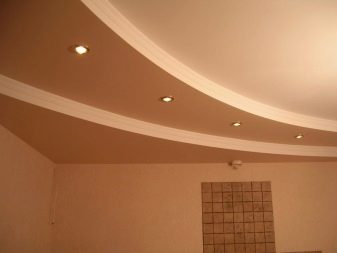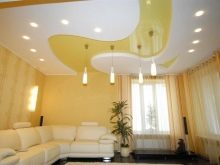Multilevel ceilings in interior design

Modern technologies make it possible to create unique finishing materials for walls, floors and ceilings. Multi-level structures are becoming an increasingly popular option for decorating ceiling spaces around the world.
You will learn about the pros and cons of multi-level ceilings in this article.



Peculiarities
Plasterboard suspended structures are used to equip the ceiling space and zoning it. You can designate the border of a particular zone in different ways - with color, level difference, lighting contrast.
As a rule, multi-level structures are used to create a spectacular and original interior. They look good in spacious rooms in which the usual ceiling is simply lost. Multilevel structures mean two- and three-level plasterboard ceilings.
To create such a ceiling, one or two levels are additionally built along its perimeter, which may have niches, ledges, curly edges. Based on the design style, the ceiling cornice comes with beveled edges, round or rectangular.



Drywall, like any other material, has its drawbacks:
- the installation of a multi-level ceiling reduces the height of the room by at least 40 mm, therefore, such structures are usually installed in spacious rooms;
- drywall is not intended to come into contact with water. Even the so-called moisture-resistant (green) drywall only tolerates high humidity in the air, but direct contact with water is contraindicated for it;
- the duration of the installation of a plasterboard ceiling depends on the complexity of the structure and can take from several hours to several days;
- drywall is a “dusty” material, when working with which be prepared for a lot of dirt and waste.



Views
Plasterboard ceiling structures are of several types. The simplest - basic ones - include single-level ceilings. Two- and three-level structures are considered varieties of complex ceilings.
Each type has its own advantages. For example, a single-level design is suitable for decorating a ceiling space in a small room. Often, it is single-level ceilings that are used in the form of a frame for installing the second tier.
Regardless of the type of suspension structure, a profile made of durable material is always used as a base... Most often, the frame is made of aluminum, wood or metal-plastic. The resulting frame is sheathed with plasterboard, and lighting fixtures are installed.


When installing a multi-level ceiling, you should know that the area of the new level will always be less than the previous one.
Unlike single-level ceilings, the installation of multi-level ceilings is more difficult. This is due to the figurality of the base, the manufacture and installation of which is much more difficult than installing a single-level ceiling.

Simple multi-level structures, in turn, are divided into the following subspecies:
- framework... Their appearance is a two- or three-level figured box located along the entire perimeter of the ceiling. As a rule, built-in lighting equipment and even engineering communications can easily be placed in such a suspended box. Often, the design of three-level ceilings is complemented by an LED strip located along the inner walls of the box;
- diagonal... In this case, the new "floor" is placed diagonally from opposite corners. It is worth noting that the visual division can be different in area, depending on the design idea. The shape of the levels can also be curly or wavy;


- three-level structures differ from two-level only in the number of suspended layers. Moreover, the more there are, the stronger the foundation should be. Different levels are painted in different colors or decorate the border between them. Of course, equipping a multi-level ceiling is much more difficult than a simple one. The greatest difficulty for the installer lies in drawing lines, along which curly and wavy levels will subsequently be built. That is why it is better to entrust the installation of a multi-level ceiling to experienced specialists who know exactly how to bring the designer's idea to life;
- zonal... Such ceilings mean dividing a room into several parts. For example, to the work area and the recreation area.


Design
The stylistic design of the ceiling space must fully comply with the design of the room. The ceiling will always be in sight and therefore is the most important part of the interior of the room.
One or another ceiling design allows you to achieve a certain effect: increase the space, divide the room into parts, create a pleasant atmosphere in the room.


The use of spotlights is widely popular when decorating multi-level ceilings. With this type of lighting, you can visually increase the parameters of the room, hide flaws. Using a pendant chandelier, you can combine the space, but spotlights, on the contrary, will help to "divide" the room into several zones.
A multi-level ceiling is often complemented with an LED strip. The illuminated ceiling will look especially impressive in the living room or corridor.


Designers offer unique solutions for multi-level structures - this is backlit hanging figures... If the size of the room allows, then you can combine different types of lamps, different in brightness and light. This approach to the design of the ceiling allows you to delimit the space and is often used for zoning a room.
When creating a multi-level ceiling, different colors are almost always used to paint the levels. The main task is to choose such shades that will be in harmony with each other, without getting out of the general style of the room. In addition, the ceiling should not irritate or draw attention to itself. It is best to use neutral shades - beige, white, pink, light brown.
The combination of stretch and false ceilings is quite common., due to which the methods of original design of the ceiling space are significantly increased.



Recently, in the design of a multi-level ceiling such original solutions as "starry sky" or photo printing are used.
"Starry sky" is obtained by installing the structure of the main luminaire made of fiber optic above the canvas. Such a ceiling will look great in the bedroom or in the children's room..
Photo printing on canvas involves applying an image using special technologies. Often, a stretch canvas with photo printing is used to decorate certain areas of the ceiling structure. The choice of drawing largely depends on the main theme of the room, the degree of illumination, and the interior.


The most popular are floral motifs, geometric shapes, abstract drawings.
Today, manufacturers offer an ultramodern novelty - 3D ceilings... Perfectly rendered three-dimensional effect allows you to embody any, even the most creative idea into reality.
It is worth noting that light shades in photo printing make the room spacious, while the dark areas seem to conceal the height of the room.However, a well-designed dark pattern can be a highlight of a room.
Using photo printing allows you to carry out the most complex design projects and make the ceiling truly unique.


Another popular type of multi-level ceiling design is fiber optic cable application, the placement of which in a certain order allows you to create delightful ornaments and patterns. This design is called light painting and opens up endless possibilities for interior decoration.

Tips & Tricks
To extend the life of a multi-level ceiling, it is important to know the rules for caring for it. It is enough to wipe the ceiling from time to time with a dry, clean cloth with soft bristles. If too much dust has accumulated, the surface can be vacuumed.
Because drywall does not tolerate moisture well, it is not recommended to wash it, otherwise, the material may swell and deteriorate. If the dirt is too ingrained in the coating, you can rub the stain with a slightly damp cloth moistened with water or a special tool.
Old stains are the hardest to remove. In some cases, you can get rid of dirt only with a new coat of paint.
Remember that streaks and stains are easy on light ceilings, so keep the cloth or cleaning brush clean.

Beautiful examples in the interior
In addition to all the advantages described above, plus multi-level ceilings is that they look equally good in the bedroom, living room, kitchen and even the hallway.
- Kitchen a multi-level plasterboard ceiling requires additional protection from moisture. It is best to paint it with waterproof enamel or cover the surface with PVC film. If the size of the kitchen allows, you can use gypsum cardboard partially, for example, only above the dining table.


- Living room - the most popular place for installing drywall suspended structures. Two- and three-level ceilings will be a real highlight of any interior. It can be a classic version, a luxurious Empire style, a delicate Provence - you choose! Modern designers often decorate the ceiling in a loft-style hall, diluting the ceiling space with plasterboard beams. For an Art Nouveau room, it is better to choose the option of a multi-level structure with straight, clear lines.



- For false ceilings in the bedroom soft, flowing shapes and gentle tones are preferred. It is appropriate to use unobtrusive images - stars, sky, floating clouds, abstract drawings. Glowing fiber optics or fluorescent patterns can help create a romantic atmosphere in the bedroom. It is better to refuse variegated colors, bulky structures, bright or too dark patterns - such ceilings will interfere with rest.



- Children's room also needs space and lightness of the interior. That is why two- and three-level suspended structures will be appropriate only in a large nursery. The smaller the size of the room, the more restrained the interior should be. The ideal option is to decorate it with an eco-style for children. The use of natural materials in their manufacture makes them hypoallergenic and safe for the health of the child. Plus, they just look great in the interior.
It is worth noting that large and bulky figures can be perceived negatively by the child's subconscious. Dimensional details are best used only to delimit space. For a small nursery, it is better to choose a lightweight plasterboard construction in warm, natural colors.


- Corridor and hallway - no less important part of the apartment than other rooms. Often, the ceiling in the hallway is decorated with vaults, arches and multi-level structures. One of the universal ways to decorate the ceiling space is the original design with many spotlights. The LED strip located along the perimeter of the corridor looks interesting.


For information on how to make a two-level plasterboard ceiling, see the next video.













The comment was sent successfully.